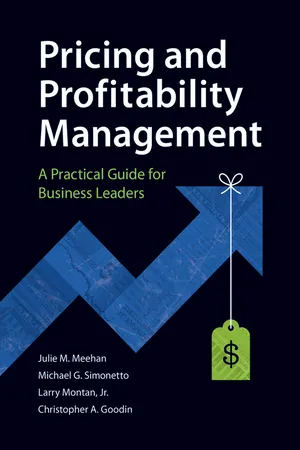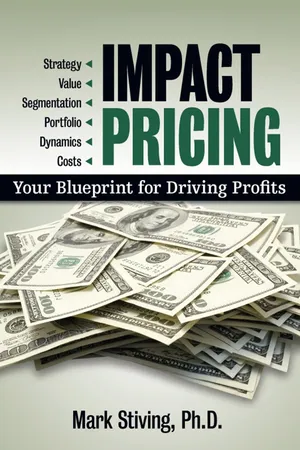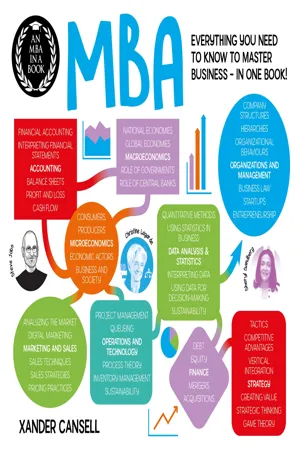Marketing
Value Based Pricing
Value-based pricing is a strategy where the price of a product or service is based on the perceived value to the customer, rather than the cost of production. This approach focuses on understanding the customer's needs and willingness to pay, and pricing the offering accordingly. By aligning the price with the value received, companies can capture more value and improve profitability.
Written by Perlego with AI-assistance
Related key terms
Related key terms
1 of 4
Related key terms
1 of 3
8 Key excerpts on "Value Based Pricing"
- eBook - ePub
Pricing and Profitability Management
A Practical Guide for Business Leaders
- Julie Meehan, Mike Simonetto, Larry Montan, Chris Goodin(Authors)
- 2011(Publication Date)
- Wiley(Publisher)
Perceived value can be influenced by a host of factors beyond the obvious benefits of the product or service, including a company's reputation, competitive offerings, technological characteristics, customer service, and advertising. Value is also affected by individual assessments, such as the emotional, mental, physical, social, and cultural gains identified with the product or service. For these reasons, value can be difficult to measure and quantify.While value represents an analysis of the market, the customers, and the offering itself, pricing requires firms to make tactical and strategic decisions based on measured value and their overall business objectives. Each product price should reflect a conscious decision by the seller either to realize all of the value or to leave some of it on the table in pursuit of another goal. For example, a company could charge minimally for razors—thereby sacrificing margin—to lock in customers, market share, and the promise of future revenue from its higher-margin razor blades.In general, a pricing strategy based on the value of a product or service has the potential to achieve more revenue and higher margins than other strategies. In Figure 3.1 , two products are shown. Customers' perceived value of Product A is higher than the price at which it is offered to the market: the difference between these two figures is the unrealized value that the company has failed to capture from buyers. Product B, on the other hand, has a lower perceived value than its price. Customers presumably would not purchase the product at the offered price, resulting in missed sales opportunities. Clearly, if prices were to be aligned more closely with the perceived value of each product, then Product A would achieve higher margins and Product B would gain additional revenue.Figure 3.1 Value versus PriceA value-based pricing strategy differs from other common pricing strategies in its focus on what a customer or group of customers is buying rather than on alternative factors (see Table 3.1 ). Under cost-plus pricing, for example, a company determines its costs in providing a product or service and then applies a desired profit margin to calculate a price. While this is certainly a simple approach to pricing, it doesn't capture the potential (available) revenue or margin for the offering from each customer or customer segment. In addition, it can be fraught with errors. In many industries, calculating unit costs accurately can be difficult because they can change based on volume. With a value-based pricing strategy, on the other hand, a company begins by understanding how each customer segment values its offering and then calculates a price aimed at capturing that value (both tangible and intangible). Table 3.2 - eBook - ePub
Impact Pricing
Your Blueprint for Driving Profits
- Mark Stiving(Author)
- 2011(Publication Date)
- Entrepreneur Press(Publisher)
Customers trade off differences in attributes for differences in prices.The concept of value-based pricing is to “charge what the customer is willing to pay.” How much do they value your product? The hardest part of value-based pricing is determining (well, estimating) what your customers are willing to pay. The easiest way to think about your value to your customers is to put yourself in their shoes. This chapter provides a model—an intuitive description—of how your customers think about value. In the next chapter we use this model to put a price on one of your products.Customers Buy Perceived Value
If you do build a great experience, customers tell each other about that. Word of mouth is very powerful.#impactpricing—Jeff BezosThe value of a product or service is measured by how much your customers are willing to pay for it. The price you decide to charge should be your best estimate of your customers’ willingness to pay. In its simplest form, your potential customers compare your product with your competitor’s product and your price with your competitor’s price. If they decide to buy a product in this category, they will buy the one that they think is the best deal for them. (As always, the term product means products, services, and all of the pieces of the offering like warranty, support, delivery, etc.).So how much is your customer willing to pay for your product? It depends on how much your competitor charges and, most important, how your product differs from your competitor’s in its ability to solve a customer problem or fill a customer need. - eBook - ePub
An MBA in a Book
Everything You Need to Know to Master Business - In One Book!
- Xander Cansell(Author)
- 2023(Publication Date)
- Arcturus(Publisher)
Cost-based pricing tends to apply to companies that operate in markets for products that are already commoditized. Value-based pricing usually applies to markets where the brand of the product might give value to the customer, or it offers unique experiences. So, the perceived value reflects the worth of the product, and the price that is paid.This kind of pricing can be determined using marketing techniques such as customer feedback or market research, which quantifies the perceived value of the experience of a particular product. To use value-based pricing, the product needs to be differentiated from the competition, should be focused on customer needs and desires, and tends to be high quality.A branded item of clothing like these jeans will probably be priced according to perceived value rather than pure cost plus margin.Use value, exchange value and price
The use value of a product includes its functional benefits, plus the amount of satisfaction it gives the consumer. This is what is used for value-based pricing.Exchange value (sometimes called economic value ) is a way of expressing value in reference to another commodity – this could be any other item or it could be money. So, if someone were prepared to exchange two pairs of trousers for one coffee maker, then the exchange value of the coffee maker would be two pairs of trousers. Similarly, when expressed in money form, the exchange value can be said to be the price, so the exchange value of the coffee maker could be expressed as $150.This exchange value is still ultimately based on use value – the value comes from the consumer understanding of its usefulness.The subjective theory of value indicates that the value of a product is not intrinsic or based solely on the labour and resources used to create it; it can be influenced by context. For instance, necessity (an umbrella has more value to you when it is raining) or scarcity (rare baseball cards can fetch huge sums of money) can alter a product’s value.One of the other elements important to value-based pricing is the next best alternative. This is the product that the consumer is most likely to purchase instead. Usually, this means that the essential features are likely to be the same, the brands are alike, and it offers the same benefits. For instance, the next best alternative - eBook - ePub
The Accidental Marketer
Power Tools for People Who Find Themselves in Marketing Roles
- Tom Spitale, Mary Abbazia(Authors)
- 2014(Publication Date)
- Wiley(Publisher)
However, companies struggle mightily to establish a pricing strategy and set effective prices. We observe that there are basically three types of pricing approaches, which we call the three Cs. The first C stands for the cost-based method. Using this approach, price is set at some predetermined percentage markup over costs. The second C method stands for the competitor-based method. This approach fixes prices at some percentage above or below the price of a competitor’s product. Despite the wide usage of both the cost-based and competitor-based methods, both of these pricing tactics have major flaws.For one thing, you’re leaving money on the table in instances where you could charge more than a cost or competitor-based approach suggests. And if you have no idea how customers value your product, you could end up with a price that makes no sense to them.The way to fix this is to employ the third C, called the customer value-based method. This approach sets prices according to the value customers receive from a product. However, many pricing strategists struggle to apply this approach, because they don’t know how to quantify the value of their products or services.The good news for Accidental Marketers is that the Ability to Win tool is exactly what is needed to set customer value-based prices. The score from this approach quantitatively measures customers’ perceptions of the value of a company’s offering and those of its competitors.By cross-referencing Ability to Win scores against prices charged in the marketplace, value-based pricing strategies indeed become possible. The tool that puts price and customer perceptual scores (Ability to Win) together is called the Perceived Value Analysis (PVA). Our friend Bradley Gale, in his popular book Managing Customer Value, - eBook - ePub
The Strategy and Tactics of Pricing
A Guide to Growing More Profitably
- Thomas T. Nagle, Georg Müller, Evert Gruyaert(Authors)
- 2023(Publication Date)
- Routledge(Publisher)
17 From Marriott to Boeing, from medical technology to automobiles, profit-leading companies now think about what market segment they want a new product to serve, determine the benefits those potential customers seek, and establish target prices those customers can be convinced to pay. Value-based companies challenge their engineers to develop products and services that can be produced at a cost low enough to make serving that market segment profitable at the target prices. The first companies to successfully implement such a strategy in an industry gain a huge market advantage. The laggards eventually must learn how to manage value just to survive.The key to creating good value is first to estimate how much value different combinations of benefits could represent to customers, which is normally the responsibility of marketing or market research. In Chapter 2 , we will define more clearly what we mean by “value” and describe ways to estimate it.Value Communication
Understanding the value your products create for customers can still result in poor sales unless customers recognize the value they are obtaining. A successful pricing strategy must justify the prices charged in terms of the value of the benefits provided. Developing price and value communications is one of the most challenging tasks for marketers because of the wide variety of product types and communication vehicles.While much of this book focuses on how to create and measure tangible economic benefits, customers are rarely the rational economic actors portrayed in traditional economic theory. An exploding field called behavioral economics has documented a host of “anomalies” in consumer decision making that run counter to the traditional economic principal of utility maximization. For example, community-held norms around fairness can limit the price a pharmaceutical firm can charge, even if the drug is a life-saver with no viable alternatives. Buyers also use mental short-cuts when making decisions, often by looking for analogous products to evaluate relative value—for this reason, many consumers view a $30 bottle of wine at a restaurant as a bargain if the other wines on the menu are priced higher; yet, the same $30 bottle will feel expensive if surrounded by $20 alternatives. - eBook - ePub
- Ross Brennan, Louise Canning, Raymond McDowell(Authors)
- 2020(Publication Date)
- SAGE Publications Ltd(Publisher)
The reason for this is that demand will be more elastic where many close substitute products are available – within an industry, the products of competing suppliers are normally regarded as fairly close substitutes for each other. Another important issue upon which some light has recently been shed is whether customer demand sensitivity is affected by investments in customer service designed to maintain and develop the supplier–customer relationship; in short, does customer relationship building through improved service deliver lower customer price sensitivity? There is some evidence to suggest that it does (Zeng et al., 2011). We return to this issue below when discussing relational aspects of business-to-business pricing, and particularly in B2B Snapshot 12.2. The ultimate form of customer-based price setting occurs where the firm aims to set price based on customer-perceived value. This is known as value-based pricing, and it is used infrequently in practice (Töytäri et al., 2015). A difficulty associated with value-based pricing is that it requires the supplier to have a good understanding of the customer-perceived value that each customer obtains from the use of their product offering. Customers themselves often resist attempts by suppliers to quantify customer-perceived value and prefer to focus instead on the supplier’s costs, particularly where cost-based pricing has been commonly used and so is considered to be the norm (Töytäri et al., 2015). It is important to understand that customer perceptions about value and price are not fixed, and that marketing managers can influence how customers perceive these factors (Hinterhuber, 2015) - eBook - ePub
Overcoming Floccinaucinihilipilification
Valuing and Monetizing Products and Services
- Jon Manning(Author)
- 2021(Publication Date)
- Pricing Prophets Pty Ltd(Publisher)
• You want to move from a transactional relationship with your customers, which has a tendency to run hot and cold, to an ongoing, value-based relationship. A subscription pricing model is ideal for this purpose.• You want a deeper relationship with your customers. This might be best facilitated with a bundling or a packaging strategy.As you can see, these are just a handful of problems that pricing can help to solve. This is why the Value-Based Pricing Canvas starts with this problem-defining discussion.Passage contains an image CHAPTER 6 PRICING PRINCIPLES You can’t haggle with a vending machine.
W ikipedia defines a principle as:“a rule that has to be or usually is to be followed… The principles of such a system are understood by its users as the essential characteristics of the system, or reflecting system’s designed purpose, and the effective operation or use of which would be impossible if any one of the principles was to be ignored.”A shorter definition of a principle can be found in the Oxford English Dictionary , which states that a principle is “a fundamental truth or law as the basis of reasoning or action.”YOUR FIRST PRICING PRINCIPLE Hopefully, one of the reasons you are reading this book is because you would like to make value-based pricing a fundamental truth, or a pricing principle, for your business. However, there are some additional pricing principles you may want to consider:• You will always quantify the economic value of your product or service, rather than picking a price point that “just feels right.”• You will always offer customers three choices to select from: good/better/best, or small/medium/large. This is also known as “Goldilocks” pricing.• Another pricing principle might be simple, all-inclusive, or “no hidden extras” pricing.• Alternatively, in a highly competitive and commoditized industry, you may choose to have a more complex pricing structure, which is difficult for competitors to match.• - Ray Donnelly(Author)
- 2010(Publication Date)
- Routledge(Publisher)
This is the benefit the customer derives from the purchase of the product. The organisation needs to understand the value that the customer places on the benefits received and then price the product accordingly. Effectively, customers assess the price and measure the benefits received. The benefits can be measurable and real or associated with confidence, or status. An example is the cost of ‘Black credit card’ which is offered to customers by invitation only. The price may be £500 per year which the customer justifies on the status the card confers alone.Other factors which affect the perceived value of the product include:- Service and after-sales service quality
- Level of differentiation from competitor products
- Quality of any packaging
- Product functionality
- Any substitute products which maybe available
The Competition
Organisations do not operate in a vacuum and must be alert to any competition in the market. That does not mean that the prices need to be the same. Understanding competitors’ objectives such as market leader, follower, or profit maximisation will enable an organisation to establish its own pricing position. Competition should not simply be based on price alone. For example, if organisation A reduces its price to below competitor B (which has more financial resources), then it may well be able to retaliate by offering deeper discounts. This ultimately has a cost to both organisations, which will be difficult to sustain beyond the short term.
Index pages curate the most relevant extracts from our library of academic textbooks. They’ve been created using an in-house natural language model (NLM), each adding context and meaning to key research topics.
Explore more topic indexes
Explore more topic indexes
1 of 6
Explore more topic indexes
1 of 4







